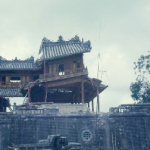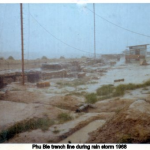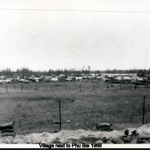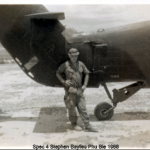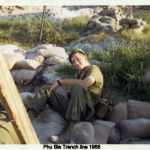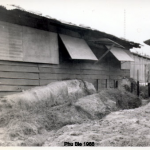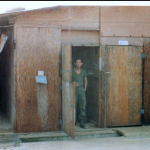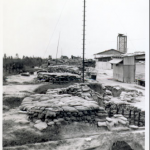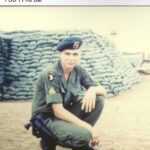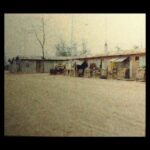FOB-1 – Phu Bai


Fob 1 was located southeast of Hue and just north of Ph Bai. The overall area was referred as "Hue / Phu Bia" Rice Paddies spreading to the east towards the sea.
They were used by the Viet Cong to use as surveillance too watch the camp. The village to the north just beyond the mine field was Phu Long. It had a small restaurant where ba luc (the dead chicken in egg) could be purchased for newly assigned Americans who would show their bravery.
FOB-1 was a combination of personalities. A Cambodian barmaid working in the US Club who had a tattoo on her left shoulder which said "Canada" Much could be said about the brave men in SOG. the Chase Medics, they risk their lives daily without the benefit of a full FOB briefing.
On November 15, 1968, FOB-1 began moving to to FOB 4, Marble Mountain, Da Nang. On November 19, 1968 LTC Bahr stood by silently while FOB 1 was closed and abandoned.
FOB-1 men and equipment was absorded by FOB-4. The Compounds name was changed to Command and Control North (CCN). FOB-1 continued it's missions from CCN, many men added to other CCN Teams. com
RT Teams
FOB 1 Personnel
| Last Name | First Name | Rank | Assignment | Start Date | End Date | AKA / Code Name | Medals |
|---|---|---|---|---|---|---|---|
| Adair | Morrris N | SFC | 11/25/68 | 12/21/68 | |||
| Adams | Richard E | SSG | |||||
| Alexander | Lyke K | Maj | |||||
| ALEXANDER | LYLE K | MAJ | C | 03/20/67 | 04/01/67 | ||
| ALMENDARIZ | SAMUEL | MSG | RT 1-0 | 07/12/67 | |||
| Alston | James E | PFC | |||||
| Altizer | Donald T | SFC | |||||
| Andreson | Kenneth M | SFC | |||||
| Andreson | Olin | SGT | |||||
| Apperson | Gerald F. | SSG | |||||
| Armijo | Maximiliano JR | SSG | |||||
| BACON | CHARLES W | SFC | S-1 NCOIC | 11/01/68 | 02/01/69 | ||
| BAHR | ROY W | LTC | FOB Commander | 07/01/68 | 11/01/68 | ||
| BAYLISS | STEPHEN | Covey | |||||
| BLACK Jr. | LYNNE | RT Idaho | BlackJack | ||||
| BORJA | DOMINGO R S | SFC | RT | 02/21/67 | |||
| BROWN | RICKEY E | SP5 | S-1 ADMIN | 10/01/67 | 09/24/68 | ||
| CARDOSA | CRECENCIO | SFC | RT | 04/10/68 | |||
| CHELLMAN | RONALD J | 1LT | S-1 ADJ | 06/01/66 | 01/01/67 | ||
| COHRON | JAMES D | SSG | RT | 11/01/67 | 01/12/68 | ||
| DICK | GAMBLE C III | 1LT | S-1 ADJ | 05/19/68 | 09/12/68 | PAUL | |
| DONLEY | |||||||
| ENRIQUEZ | MANUEL Z | SGM | DET SGM | 07/01/67 | 06/26/68 | ||
| GARCIA | ARTHUR F | SSG | RT 1-0 | 01/01/67 | |||
| GREEN | HERBERT L | MSG | RT | ||||
| GREEN | ROBERT C | 1LT | S-1 ADJ | 12/04/67 | 05/19/68 | ||
| GREENEY | CLAUDE L | SFC | S-1 NCOIC | 11/14/68 | |||
| HAMBY | DOLPH F JR | MAJ | FOB Commander | 05/15/66 | 06/01/66 | ||
| HAMILTON | GILBERT L | SFC | RT NC 1-0 YDY | 08/21/67 | 02/02/68 | ||
| HARRIS | HEARVEY A JR | SGM | DET SGm | 04/01/68 | 11/09/68 | ||
| HOWRD | RICH | ||||||
| HUYCK | EDWARD | SP5 | S-1 CLERK | 08/01/67 | 07/28/68 | ||
| INGLE | FRANCIS P | 1LT | S-1-ADJ | 09/01/68 | 05/12/69 | ||
| JOHNSTON | BRUCE | Medic | |||||
| JUENEMANN | MICHAEL G | 1LT | S-1 ASST | 12/31/67 | 12/27/68 | ||
| KING | |||||||
| LANE | |||||||
| LEE | HOWARD F | MAJ | FOB Commander | 06/06/68 | 06/30/68 | ||
| LOPEZ | ROBERT | LTC | FOB Commander | 03/03/68 | 03/06/68 | THREE FINGER | |
| LUCERO | LOUIS A | SFC | RT 1-0 | 10/01/67 | 09/10/68 | ||
| MARTIN | JAMES W | SP4 | S-1 CLERK | 11/01/68 | |||
| MCGINN | STANLEY P | SFC | S-1 NCOIC | 07/01/67 | 04/09/68 | ||
| MCGOLRICK | ELWOOD F | SFC | RT 1-1 | 04/01/67 | |||
| MCGOVERN | JOHN | SFC | |||||
| NICELY | CLYDE D | SFC | RT 1-1 | 09/01/67 | 08/18/68 | ||
| PARKS | Spider | ||||||
| PATTON | FREDERICK C | MAJ | FOB Commander | 06/01/67 | 08/21/67 | ||
| PETERS | HOHN | ||||||
| RATLIFF | CLARENCE C | MAJ | FOB DCO | 3/07/67 | 07/02/68 | ||
| RICKARD | JOHN R | SFC | MESS STEW | 01/01/68 | 12/18/68 | ||
| Roberston | John H | SFC | RT 1-0 | 09/01/67 | 05/20/68 | ||
| ROBINSON | JOHN R JR | CPT | S-1 ADJ | 12/24/66 | 12/04/67 | ||
| ROMANCIK | RONALD | ||||||
| ROUGEAU | JAMES L | MAJ | S-3/FOB CO | 04/01/67 | 06/06/67 | ||
| RUGGER, | FRANK | MAJ | FOB XO | 06/01/68 | |||
| RYBAT | EDWARD S | MAJ | FOB Commander | 08/22/67 | 02/01/68 | PANZER | |
| SCURLOCK | SCURLOCK | SSG | RT | 10/01/67 | 12/21/67 | ||
| SHAFFT | |||||||
| SHELTON | WILLIAM L | MAJ | FOB Commander | 11/01/68 | 02/01/69 | BILL | |
| SHELTON | WILLIAM L | MAJ | FOB DCO | 08/01/68 | 12/01/68 | BILL | |
| SINCERE | CLYDE J JR | MAJ | FOB XO | 04/01/68 | 06/15/68 | ||
| SMITH | PEYTON J | SFC | RT 1-0 | 01/01/68 | |||
| SMITH | WILLIAM F | LTC | FOB DCO | 03/01/68 | 03/06/68 | ||
| SMITH | DAVID C | MAJ | FOB XO | 09/01/67 | 02/01/68 | BULLDOG | |
| SMITH, | WILLIAM F | LTC | FOB Commander | 03/06/68 | 06/06/6 | ||
| SNELL | IRA | MAJ | FOB Commander | 08/22/67 | 03/02/68 | ||
| SPAULDING | JOHN E | SFC | MESS STEW | 12/01/67 | 11/01/68 | ||
| STAPLETON | PAUL E | SFC | MESS STEW | 08/01/68 | |||
| SULLIVAN | ROBERT J | SFC | RT 1-1 | 07/12/67 | |||
| SWAFFORD | TERRY F | SFC | ST / Mess | 01/ /66 | 03/31/67 | ||
| TARRER | CHARLES L | SGT | RT 1-0 | 04/24/69 | |||
| VALLEJO | URBANO | SP4 | S-1 CLERK | 02/01/68 | 01/06/69 | ||
| VAN SICKLE | JAMES P | MAJ | FOB Commander | 07/01/66 | 03/20/67 | SHRIMPBOAT | |
| VICKERS | CHARLES G | SGM | DET SGM | 1967 | CHARLIE | ||
| WILSON | HUGH M | SP4 | S-1 CLERK | 03/01/68 | 02/01/69 | ||
| MITCHELL | ARTHUR JR | SFC | House 22 | 06/15/68 | 02/08/69 | ||
Operation 35 (Ground Studies Group) Shining Brass / Praire Fire
SOG needed a permanent base camp in the northern part of South Vietnam. This camp would allow SOG teams easy access to North Vietnam, the shinning brass targets in Laos and the Demilitarized Zone (DMZ).
A location for the SOG camp was selected at an existing Vietnamese military compound at Phu Bai, outside the wire on the northwestern-most end.
Shining Brass Operations 1966
The adjacent Vietnamese camp also contained an air strip. which benefited SOG operations. Construction was begun on the Phu Bai Camp in March, 1966 and was completed by July 1966 when Major Van Sickle assumed command of the camp.
Five recon teams were formed to begin operations. The teams were launched from two sites. One Khe Sanh air strip which had been established by Major Charles W. Norton Jr. during June 1966 and called the forwarded operation base FOB-1
The other was directly across the road from the base camp’s main gate and allowed launches into south Laotian targets areas which bordered and joined with Kontum’s “Shinning Brass” northern reconnaissance area.
The “Shining Brass” areas for Phu Bai and Kontum overlapped in the vicinity of Ashau Calley and gave the camps a joint responsibility for conducting recon missions into the valley on a rotating basis. Ashu Valley (‘the valley of death”) swarmed with enemy activities and SOG missions were run into the valley to harass, interdict and disrupt the enemy’s movement and plans.
The Khe Sanh launch site allowed access to the northern targets of “Shinning Brass” and camp’s launch site allowed launching into the southern areas which inter-meshed with Kontum’s northern recon areas.
Over commitment of the recon teams was becoming a common problem and newly extracted teams found themselves faced with almost immediate reinsertion into the same target areas. The over zealous, unrealistic demands placed the commanders in a pressure situation and caused men to agree to be inserted without proper pre-reconnaissances preparation of planning.
Newly arriving SOG volunteers quickly learned of SOG’S 80% casualty rate in recon operations and not to volunteer for duty at Phu Bai. Phu Bia had become notorious for the loss of lives. It was not an adventure to be in Phu Bai, but a trial for survival of the fittest.
FOB-1 1967
Impossible Missions- provided the necessary excitement for volunteers and a challenge to return from a mission alive.
Words cannot express the fears of those who faced death on a daily basis in the course of their “normal” duties. To some, this allure and silent bond between men was Phu Bai.
My March 1967, the code name “Shining Brass” had been compromised by the US News media. Other Code names (Prairie Fire) took its place and allowed expansion in SOG recon programs. Plane had been prepared which would spread operations across a wider face of enemy held territory.
Phu Bai assigned to four missions which included:
Prairie Fire – Reconnaissance of the Ho Chi Mind Trail in Laos.
Nickel Steel – Recon operations in the western portion of the demilitarized Zone (DMZ).
Muscle Shoals – The placement of sensors equipment in the western end and south of the DMZ. SOG sensor operations in Laos were code name Igloo White.
Downed Pilot – Pilot rescue in North Vietnam.
In July 1967 Major Van Sickle departed the FOB and was replaced by Major Edward S. Rybat.
Dangerous operations continued, casualties mounted and not enough Special Forces volunteers could be found fast enough to fill the empty positions on the recon teams. Men were sought from other Army recon units in Vietnam. Volunteers included men from the 173rd ABN. All who dared were welcome to try their luck at Phu Bai.
Changes became a way of life to the men who conducted recon operations. They became well suited to flexibility and improvised diversions.
By late summer the camps at Kontum and Phu Bai assumed the old launch designations Foward Operations Base (FOB). Phu Bai was designated as FOB-1 and Kontum FOB-2.
In August 1967, the recon teams increased in numbers from five to seven teams at Phu Bai,
During October 1967, MACVSOG 35 camp FOB-3 at Khe Sanh under went a relocation and reconstitution.
A Safe House had existed in Hue, but was no longer necessary to the function of the FOB and was closed by Fall of 1967.
Camps built by 5th Specials Forces Group “A” Detachments along the border were also used periodically as a “jumping off and stand-by position for SOG launch sites. The personnel always included a Launch NCO and an FOB “Chase Medic”
During November 1967, the recon teams were increased in numbers from seven to ten teams. Sergeant Major Rodriguez assumed the role of the camp’s senior enlisted man.
In December, Major Rybat departed the FOB for reassignment to the USA and was replaced by Major Snell.
Late January 1968, Khe Sanh was besieged by forty thousand NVA soldiers shelling Khe Sanh with 122mm and 152mm artillery. The NVA and CV build up was significant and the ho Chi Minh trail teemed with heavy NVA and VC traffic. The NVA nand VC massed in the Ashau Valley and caused operations setbacks for SOG.
At 1700 hours on January 31, 1968 the NVA attacked FOB-1 hoping to catch the Americans off guard. May of the men were in the mess hall having dinner, unarmed when the shelling started. The intense fire power consisted of NVA mortars and rocket fire. Three building in the compound were destroyed as a result of the shelling.
March 3, 1968. Major Snell departed from FOB 1 and was replaced by Major Lopez. Major Lopez, during his in briefing, was told of the failed and aborted reconnaissance mission from FOB-. He was told that team leaders were refusing to insert in the the Ashau Valley. Lopez became irate. On March 4, 1968, Major Lopez, in an attempt to motivate the men he (Lopez) accompanied an inserting FOB recon team in the Ashau Valley. After two days in the Ashau Valley, he was killed in Action. He had been FOB-1 Commander for three days.
March 6, 1968, Major Lee assumed command of FOB-1. Later in March 1968, the NVA siege at Khe closure of FOB-1 launch site at the air strip. The launch site was moved within a newly built camp at FOB-3 just outside the Marines perimeter wire. After several futile attempts at the insertion and support of inserted teams from FOB 3 camp, the launch operations was returned to the base at FOB-1. Any hopes of salvaging or using the launch site at Khe Sanh were abandoned.
The FOB launch area across the road from the FOB became a primary launch site for the FOB (Mai Loc) was later added after the siege of Khe Sanh.
Shortly after April 1968, SOG reconnaissance symbol sign was affixed to the US Club. The sign was a Skull wearing a green beret and FOB-1 proudly adorned to it’s banner.
During May 1968, the FOB’s Hatchet Force was locked into a devastating battle with the North Vietnamese Army for ten days which caused many causalities for FOB-1.
In June 1968, not desiring a recurrence of the May battle, Cambodian in the Hatchet Force threatened the life of a American Special Forces (Snake Bite) officer from Okinawa, who was acting as the commander of the Hatchet Force. The Cambodian refused to re-enter the Valley. A few days later, before noon, the Hatchet Force was formed in the FOB main street awaiting lunch in the mess hall. A jeep with a .50 caliber machine gun pulled up in front of the formation. The gun was leveled at the Cambodians and they were ordered to remove their US issued clothing and boots. The stripped men were herded over to the neighboring strip in the Vietnamese camp, loaded onto Blackbirds (C-130 Aircraft), flown to Saigon’s Tan Son Nhut air base. They were marched to the airbase main gate and turned loose on the the streets of Saigon.
While the Phu Bia FOB and Mai Loc launch area were abandoned in the move to consolidation forces at CCN, the area of Phu Bai was looked at as a possible launch area. The area was adjacent to SOG’S Laotian target area and was secured by the 101st Airborne Division. The 101st camp was named Camp Eagle.
Air Assets
19th Tactical Air Support Squadron TASS – This was the first Tass unit assigned to Vietnam, August 4th, 1964 the unit was directed to transfer it’s O1- Bird Dogs Aircraft to the South Vietnamese Air Force and was inactivated. October 31, 1964, the unit was reactivated at Bien Hoa, Forward Air Controllers (FACs) were provided byt the 19th TASS to complements SOG mission and increase the success probability.
20th Special Operations Squadron (SOS) – The 20th SOS had twenty- Three UH-IP and fifteen UH-1N helicopters assigned. Eleven helicopters were used by SOG on an average daily basis.
90th Special Operations Squadron (SOS) – by April 14th 1967, the 90th Special Operations Squadron redeployed from Bien Hoa air base to Phan Rang Air Base. December 12, 1969, the unit was redesignated as the 90th Attack Squadron. Ocber 31, 1970 they were redesignated as the 90th Special Operations Squardon and relocated to the Nha Trang Air Base.
Vietnamese Air Force 219th Kingbee H-34 Helicopters –
VNAF Helicopter pilots. We flew in unmarked CH-34 helicopters code named “Kingbees”. The Kingbee pilots were legendary in C&C — especially two we called “Cowboy” and “Mustacio”. They flew in near “zero ceiling” weather and without gunship support to extract teams. They hovered against steep hillsides and even used their rotor blades to “cut” through vegetation in order to get to the teams.
Supporting Command and Control North
US Army
2nd Squadron, 17 Cavalry, 101st Airborne
17th Aviation Company, 101st Airborne
188th Assault Helicopter Company, 101st Airborne
4th Battalion, 77th Aerial Rocket Artillery, 101st Airborne
Co B. 158th Assault Helicopter Battalion
Co C. 158th Assault Helicopter Battalion
Co D. 158th Assault Helicopter Battalion
US Marine Corps
HMM-165 VMO-2, VMO-3 and VMO-6
South Vietnamese Air Force
219th Squadron – Kingbees
Information and Sources
SOG: The Secret Wars of America’s Commandos in Vietnam | John Plaster |
| R. Gillespie | Black Ops Vietnam |
Stephen Sherman – Who’s Who from MACV-SOG
Harve Sal – SOG, MACV Studies and Observations Group
| wikipedia.org | https://en.wikipedia.org/ |


















